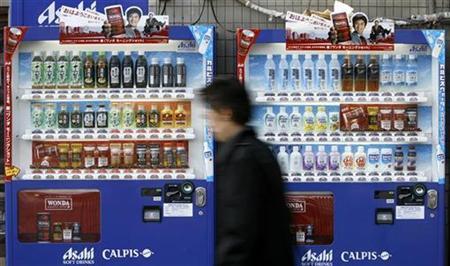London – In Japan, they are like traffic lights – they’re everywhere. Nearly 5 million “jido hambaiki” – vending machines – populate the world’s third-largest economy, one machine for every 25 people.
The high-tech country has the highest density of such machines. Nearly half of them dispense upwards of 30 different beverages: soft drinks, water, green tea, coffees and even soups, all from one machine.
But Japan’s jido hambaiki boom appears to be over. The “kombini” market, a kind of convenience store that is open 24 hours a day, is taking on the vending machine business.
“I used to drink vending machine coffee,” one Tokyo office worker said, but now these human-run stores are selling freshly-brewed coffee that is not only cheaper, but tastes better.
The vending machine makers are starting to feel the pinch and aim to fight back. Last year their sales fell to two trillion yen (17.8 billion dollars), down by more than a third from 1995, when jido hambaiki sales reached a record high of 3.1 trillion yen.
In the mid-1990s, Japanese were buying 48 per cent of their beverages from a machine, but last year this had dropped to 29 per cent, according to statistics reported by the beverages research institute Inryo Soken, compared with a 22 per cent share for the Kombini markets.
Despite the competition, the beverage industry is still going with vending machines, Kazuhiro Miyashita of Inryo Soken reports, because the profit margin is high.
And it’s not just the beverage industry. There are vending machines for a wide range of different products – ice cream, fruit and vegetables, handkerchiefs, instant boiled noodles, batteries and stockings.
Vending machines don’t require any personnel, “that’s why they are important for many beverage makers,” says Miyashita.
To assure that vending machines keep attracting Japanese consumers, the makers are constantly coming up with new ideas. Newer generations of machines have started to speak with the customer and even recommend the appropriate beverage.
Facial recognition software is being used to “recognise” the person’s gender and age with a high degree of accuracy and then combine this with the time of day and the weather conditions to create the right drink recommendation.
In other leading economies around the world, vending machines are nowhere near as advance or as prevalent.
In the German market, the largest in Europe, vending machines selling mainly hot and cold beverages number just half a million, according to German Vending Machine Federation figures. That’s a fifth of the amount of beverage vending machines in Japan (2.47 million).
In Japan’s rural regions, some farmers that operate stores will use vending machines for their food products during the closing-time hours. Bakers and butchers also offer their products with machines. The machines are operated by touch-screen and provide for a variety of ways to make payment.
There are even some vending machines that dispense items free of charge, especially in times of catastrophe, for example after an earthquake.
After the March 2011 tsunami catastrophe in north-eastern Japan, more than 100,000 drinks were dispensed in the region this way. Some vending machines are being outfitted with displays to provide news reports and information about evacuation measures.
Consideration is even being given to vending machines with medical devices to treat heart-rhythm disturbances.
There appears to be no limit to the vending machine makers’ imaginations. The future of the machines, says Shoji Mamamoto, marketing and consumer behaviour professor at Kwansei Gakuin University, depends on whether they provide added value to people.
For now, this distinctly Japanese industry is being forced by Kombini markets to delay the installation of new vending machines.
